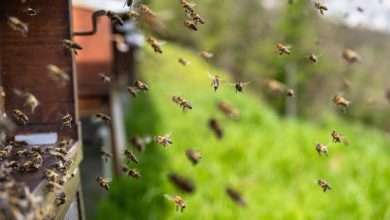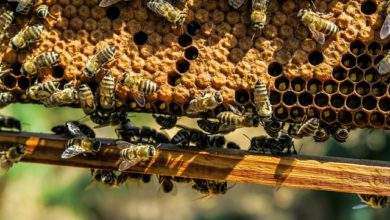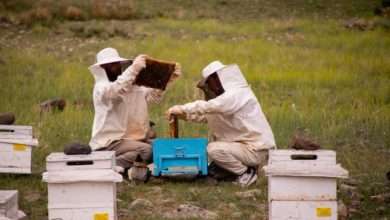Bee Math
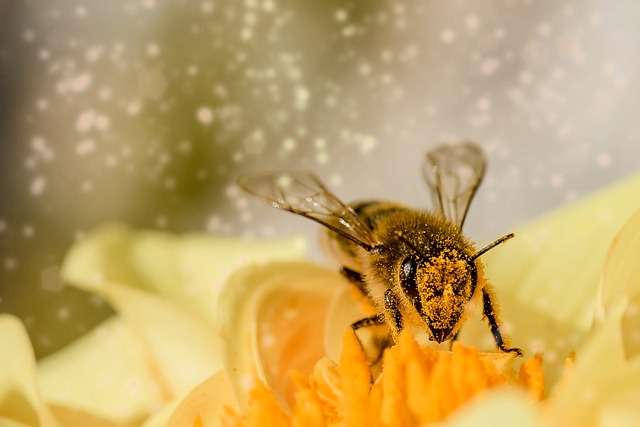
Bee math encompasses a range of mathematical concepts, from simple addition and subtraction to complex trigonometry. One key area of bee math is spatial reasoning. Bees are able to navigate complex environments, such as their hives and the outside world, thanks to their ability to understand space and distances.
In addition to spatial reasoning, bees also use math to communicate. They use dance-like movements to convey important information about the direction and distance of food sources. This type of communication, known as the waggle dance, is a testament to the power of bee math.
Importance of Bee Math in Understanding Bee Behavior and Ecology
Understanding bee math is crucial to understanding bee behavior and ecology. For example, by studying the waggle dance, we can learn about the types of flowers bees prefer, how far they are willing to travel for food, and even how they respond to changes in the environment.
Bee math can also help us better understand the health of bee populations. For instance, if bees are having trouble navigating their environment, it could be a sign that something is wrong with their habitat or food sources.
The Mathematics of Bee Communication
Bees are known for being excellent communicators. Without the use of spoken language, they are still able to communicate with each other in a highly effective way. Their complex communication system revolves around the use of dance, specifically the Waggle Dance.
Waggle Dance Mathematics
The Waggle Dance is a method of communication used by bees to convey the location of important resources, such as food or water, to other members of the hive.
There are three main components to the Waggle Dance:
- Description of the Dance: A bee performs a figure-eight dance on the surface of the comb.
- How Bees Use Waggle Dance: The intensity and direction of the dance convey to other bees the location of the food source.
- Mathematics Behind the Waggle Dance: There are three key factors that allow the bees to convey the precise location of the food source: timing and duration of dance, angle of dance, and distance and direction calculation.
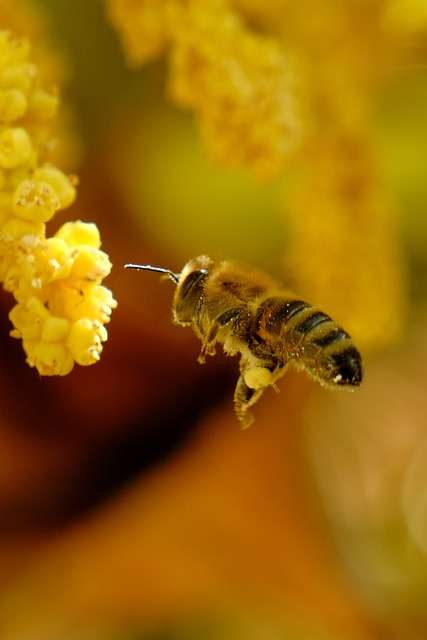
Timing and Duration of Dance
The duration of the dance corresponds to the distance to the food source in a linear fashion (longer duration equals a greater distance). The timing of the dance also corresponds to the time of day that the food source is available. For example, the dance performed in the morning may differ from the one performed in the afternoon.
- Angle of Dance – The angle of the dance is used to convey the direction of the food source. Specifically, the angle of the sun in relation to the honeycomb, along with the angle of the dance, can be used to determine the direction of the food source.
- Distance and Direction Calculation – Using the duration of the dance and the angle of the dance, bees can calculate both the distance and direction of the food source. The distance is determined by the duration of the dance, while the direction is conveyed through the angle of the dance in relation to the sun.
Importance of Waggle Dance in Bee Biology
The Waggle Dance is a crucial method of communication for bees as it allows them to effectively forage for food and locate new hive sites. By being able to communicate important information to each other through the Waggle Dance, bees are able to better function as a cohesive unit and ensure the survival of the colony.
- Foraging – The Waggle Dance allows bees to effectively communicate the location of food sources to other members of the hive, ensuring that all members of the colony are able to forage and collect resources efficiently.
- Hive Location – The Waggle Dance is also used to communicate the location of new hive sites. By being able to locate and communicate a new hive site through the Waggle Dance, bees are able to establish a new colony and ensure the survival of the species.
Honeycomb Geometry
Honeybees, as we know, are essential pollinators for our environment and provide us with honey, beeswax, and other valuable products. But there’s one aspect of their lives that is often overlooked – honeycomb.
Honeycomb is the hexagonal wax structure that bees build to store their brood and honey. Honeycomb plays a crucial role in the health and productivity of a bee colony
- Hexagonal and Triangular Cells
The geometry of honeycomb is fascinating. Bees have the innate ability to construct hexagonal cells that are uniform in size and shape. Hexagonal cells provide the maximum amount of storage space while using the least amount of material. This is an important feature for bees, who must produce enough honey to sustain themselves through the winter months.
In some cases, bees may also construct triangular cells. Triangular cells tend to be smaller than hexagonal cells and are used mainly for storing pollen and may also be used as a nursery for developing larvae.
- Bee Space
Another important aspect of honeycomb construction is bee space. Bee space is a small gap or distance that bees leave between the comb and other hive components, such as frames or walls. Bee space is critical for bees to move freely around the hive and to maintain proper temperature and humidity levels.
Mathematics of Honeycomb Construction
- Optimal Geometry for Storage and Health
The mathematical principles behind honeycomb construction are fascinating. Bees innately understand that hexagonal cells provide the most storage space while using the least amount of wax. This optimal geometry is essential for a bee colony’s survival and productivity.
Hexagonal cells are also optimal for hive health. They allow for efficient nest ventilation and prevent moisture buildup, which can lead to the growth of harmful bacteria and fungi.
- Honeycomb Production Efficiency
Honeybees have evolved to be highly efficient in the production of honeycomb. They can produce wax flakes from their bodies, and each worker bee can produce about .2 milligrams of wax per day. It takes about 8.4 kilograms of honey to produce one kilogram of wax. The efficiency with which bees produce wax and construct honeycomb is essential for their survival.
Importance of Honeycomb in Hive Health

- Home for Brood and Bees
Honeycomb provides a home for the developing brood and adult bees. The hexagonal cells are perfect for storing eggs, larvae, and pupae and provide an ideal environment for them to grow and develop.
- Honey Storage
Honeycomb is also essential for storing honey. Bees use the hexagonal cells to deposit nectar and then fan their wings to evaporate the water content, turning it into honey. The honey is then caped with beeswax, ready for storage and future use.
Fractal Geometry and the Bee Hive
Introduction to Fractal Geometry
Fractal geometry is a fascinating branch of mathematics that explores complex, irregular shapes and patterns found in nature and the world around us. It has been described as the study of objects that maintain their detailed patterns even as they change scale.
Fractal geometry has found applications in various fields, including medicine, climate science, and architecture. However, its remarkable potential in understanding bee behavior and hive construction remains one of the most intriguing areas of study.
Fractal Geometry and the Bee Hive
The honeybee, often referred to as “nature’s mathematician,” constructs its hive in an intricate, yet beautiful fractal pattern. The honeycomb structure of the bee hive is made up of hexagonal cells, each one precisely aligned with one another. The self-similar pattern of the bee’s hive is a powerful demonstration of fractal geometry in the natural world.
Natural Process of Cell Building
Bees are intelligent creatures that operate in a highly organized and efficient society. Honeybees build their comb structure using wax, which they produce from their glands in their abdomens.
Each cell is built at a precise angle of precisely 120 degrees, ensuring that every cell is equidistant from each other. This pattern of cell building is not only necessary for their survival but also has aesthetic properties that enhance the overall structure and design of the hive.
Self-similar Patterns of Bees
Fractal geometry principles are evident in each individual cell and the overall structure of the honeycomb. The hexagonal shape of each cell is self-similar, meaning every cell is a miniature version of the entire hive structure.
This pattern repetition ensures each cell retains its optimal space, allowing the bees to thrive and communicate with one another effectively. The orientation and placement of each layer build upon one another, leading to a tightly packed architectural masterpiece.
Bee Hive Fractals in the Natural World
The honeybee’s fractal architecture is not limited to their hive structure alone. The hexagonal shape and organization are also evident in the way bees gather nectar from flowers. These patterns allow the bees to optimize their foraging efficiency, ensuring that they utilize every available drop of nectar.
Importance of Fractal Geometry in Bee Ecology
Fractal geometry plays a vital role in ensuring the efficiency and health of the honeybee colony.
Increased Efficiency in Colony Health
The fractal pattern of the hive structure ensures an optimal use of space, which is essential for the colony’s survival. This efficient use of space also ensures optimal temperature control and ventilation throughout the hive, crucial for the bees’ survival.
The bee hive’s fractal pattern also plays a vital role in defending the hive against predators and disease.
Applications Outside of Beekeeping
Understanding the fractal patterns and organization that the honeybees use in their hive construction may have numerous practical applications beyond beekeeping.
From civil design to architecture, this interaction of nature and math has the potential to revolutionize the way we approach design and construction in a more organized and functional manner.
Conclusion
Bee math is an incredibly complex and to-date largely unknown field of study. Through the implementation of precise mathematics and genetics, scientists and beekeepers alike can better assess bee populations and, ultimately, their behaviors.
Through population structure modeling, scientists can gain a better understanding of the global bee population which can then be used to enact change and policy in order to protect these endangered species and the global ecosystem which they help sustain.
FAQ
What is beekeeping math?
- Beekeeping math is a form of calculation that helps beekeepers keep accurate track of their hive’s performance, which can ultimately lead to more successful beekeeping businesses.

How do I calculate the number of bees in a hive?
- To estimate a hive’s population, count the number of frames covered in bees and multiply by 1,500 to 2,000 bees per frame, depending on the time of year.
How does beekeeping math help beekeepers?
- Beekeeping math helps beekeepers make informed decisions about when to harvest honey, how much honey to leave for the bees, and how much the hive has grown or shrunk over a given period.
What are some common calculations that beekeepers make using beekeeping math?
- Some common calculations include determining honey yields, assessing hive health and bee population growth, and measuring varroa mite infestations.
What is a five-frame nuc, and how many bees can it hold?
- A five-frame nuc is a small hive that accommodates five frames of comb. It can hold around 10,000-12,000 bees, although this can vary depending on factors such as genetics, climate, and forage availability.
How does beekeeping math contribute to a successful beekeeping business?
- Tracking hive performance and optimizing honey yields can lead to greater profits for beekeepers, especially in commercial settings.
Are there any potential downsides to using beekeeping math?
- As with any form of data collection and analysis, there is a potential for error or misuse. However, as long as beekeepers are diligent about accurately inputting data and interpreting the resulting calculations, beekeeping math is a valuable tool for any beekeeper.
